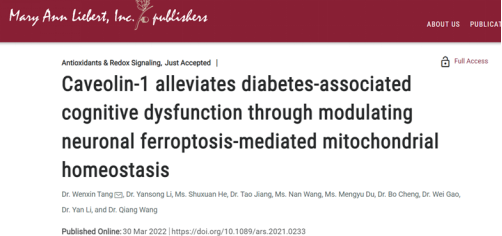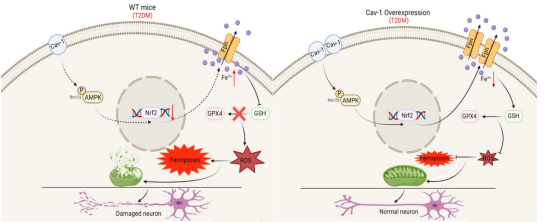Recently, the research team led by Professor Wang Qiang from Department of Anesthesiology and Perioperative Medicine of the First Affiliated Hospital of Xi 'an Jiaotong University (XJTU) published an article entitled “Caveolin-1 alleviates diabetes-associated cognitive dysfunction through modulating neuronal ferroptosis-mediated mitochondrial homeostasis” in Antioxidants & Redox Signaling (IF=8.401 in 2020), which illustrated novel findings regarding the prevention and treatment mechanism of diabetes-associated cognitive dysfunction (DACD). This study innovatively suggests that ferroptosis in hippocampal neurons is the key pathological mechanism and prevention target of DACD at the animal and cellular levels.

Diabetes mellitus has significantly increased the incidence of hypoglycemia, ketoacidosis and cardiovascular and cerebrovascular adverse events. DACD is an important complication of diabetes mellitus, while its pathogenesis remains to be clarified. Ferroptosis has been proven to be involved in the incidence and development of many neurodegenerative diseases, and the metabolic abnormality of iron ions is intimately associated with diabetes mellitus. Nevertheless, the role of ferroptosis in DACD is still unclear. Professor Wang Qiang's research team published a Review entitled "Caveolin-1, a Novel Player in Cognitive Decline" in Neuroscience and Biobehavioral Reviews (IF=8.989 in 2020) in June, 2021, which illustrated the role of caveolin-1 (Cav-1) in neurodegenerative diseases. However, the mechanism underlying how Cav-1 can alleviate the neuronal damage caused by type 2 diabetes mellitus (T2DM) is still unknown. Accordingly, the research team proved, for the first time, that ferroptosis may be the main form of neuronal death in DACD, and further explored the role and exact mechanism of Cav-1 in attenuating DACD.
This study innovatively confirms that ferroptosis of hippocampal neurons is the key pathological mechanism of DACD at the animal and cell levels, and ferroptosis is probably the main pattern of neuronal death induced by T2DM. Specific inhibition of ferroptosis can effectively improve mitochondrial function, synaptic function and cognitive impairment of hippocampal neurons in T2DM mice, and significantly inhibit neuronal apoptosis. These findings provide a novel theoretical basis for exploring the incidence and progression of DACD. In addition, this study identified, for the first time, that cav-1 significantly improved the cognitive function of T2DM mice through the AMPK/Nrf2/Fpn signaling pathway, which provided a novel target and strategy for the prevention and management of DACD.

The First Affiliated Hospital of XJTU is the first and corresponding affiliation. Professor Wang Qiang and Professor Li Yan are co-corresponding authors. Tang Wenxin, a doctoral student, is the first author, and Li Yansong, an assistant researcher from Department of Anesthesiology and Perioperative Medicine, is the co-first authorof this article. This study was supported by Surface Project of National Natural Science Foundation of China and Natural Science Foundation of Shaanxi Province.
Article link: https://www.liebertpub.com/doi/10.1089/ars.2021.0233